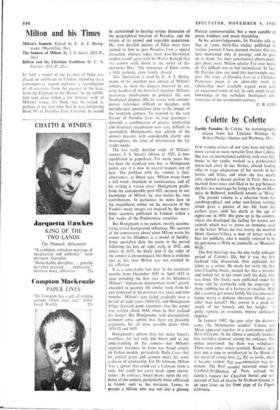Colette by Colette
Earthly Paradise. By Colette. An Autobiography drawn from her Lifetime Writings by Robert Phelps. (Secker and Warburg, 45s.) FEW women writers of our time have led fuller, more varied or more versatile lives than Colette. She was an international celebrity with over fifty books to her credit, worked as a professional music-hall artist in her thirties, played leading roles in stage adaptations of. her novels in her forties and fifties, and when she was nearly sixty opened a beauty parlour in Paris. She was married three times and filled in the gap between the first two marriages by living with the ex-Mar- quise de Belboeuf, familiarly known as 'Missy.'
The present volume is a selection from her autobiographical and other non-fiction writings which gives a picture of her life from her earliest years until her death at the age of eighty-one in 1954. She grew up in the country, where she developed the feeling for nature and animals which was to prove an immense asset to the writer. When she was twenty she married Henri Gautier-Villars, a man of letters with a flair for publicity, who is usually referred to by his pen-name as Willy or, ironically, as 'Monsieur Willy.'
The first marriage was the one really unhappy period of Colette's life, but it was the first husband who discovered, then exploited, her talent as a writer. He made her write the first four Claudine books, treated her like a prisoner and locked her in her room until the daily stint was dope. The books were published under his name and he eventually sold the copyright in them, robbing her of a fortune in royalties. Why did a country girl whose family life was unusually happy marry a dubious character fifteen years older than herself? Her answer is a good ex- ample of her honesty and her insight: 'A guilty rapture, an atrocious, impure adolescent impulse.'
In January 1907, the year after the divorce, came 'the Montmartre scandal.' Colette and Missy appeared together in a pantomime called Reve d'Egypte. At the climax a specially luscious kiss started a clamour among the audience. The police intervened; the show was withdrawn. There were other minor scandals. Readers' pro- tests put a stop to serialisalton in Le Matin of her novel of young love.,.Ee BM en herbe, when it became evident tluit con;ummation was im- minent. The final- scandal
when the Cardinal-Archbishop of occurred
Paris refused the family's request for Christian burial and was accused of lack of charity by Graham Greene in Lanineorpeainreletter on the front page of Le Figaro The book contains delightful pictures of coun- try life—Colette's true 'earthly paradise'—vivid portraits of her contemporaries and an ample dose of her particular brand of wisdom. She speaks sadly of her two 'catless' years. In one of the scenes from rural life we see 'silver- coated rats squatted at ease, eating their meal of grapes straight from the vine; the big snake, caught in the trellis of the hen run, [which] could not escape the fowls' ferocity'; the swallows 'ruling the cat with extreme rigour, driving it away with sharp blows of their beaks and shrill whistling war cries.' Human beings are equally disconcerting. A lesbian poetess says of a man whose work she does not admire: 'He's a cunt, a cunt with a pen.' There is the 'immodest child' who taught Colette 'with unembarrassed com- petence' that 'there are fewer ways of making love than they say, and more than one believes.' Lastly, there is a fascinating glimpse of la Belle Otero,' probably the most ruthless and expensive strumpet of the century, at the theatre, 'rigid in her gala corsets, her huge breastplate of jewels
plastered to her chest . a motionless icon.'
Mr Phelps provides a useful chronology at the beginning of the book, but in spite of his reservations, more notes or links between the different sections would have made the story easier to follow. In his anxiety to make the picture as complete as possible, he has drawn too frequently on Colette's less interesting writings. Five hundred pages is too generous a helping and there are, inevitably, longueurs. But it is a gorgeous bedside book.
MARTIN TURNELL



































 Previous page
Previous page